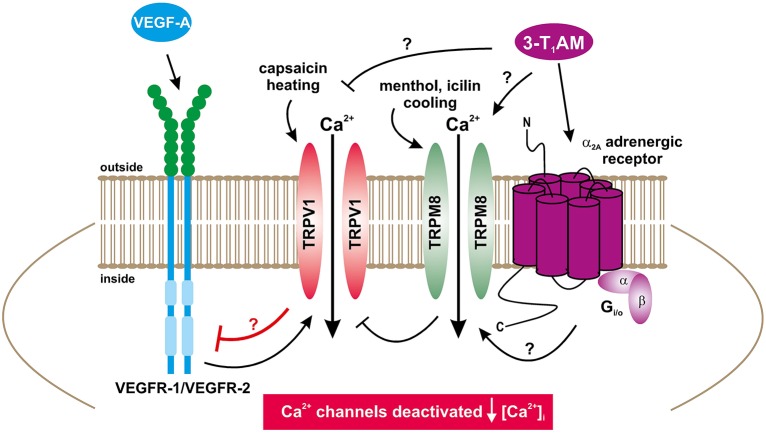Figure 12.
Suggested Ca2+ signal transduction model accounting for how TRPM8 activation affects receptor-linked signaling pathways (Mergler et al., 2014; Khajavi et al., 2017). Ca2+ channels such as TRPs of the TRPV1 subtype (capsaicin receptor) can be selectively activated by heat (>43°C) or capsaicin and blocked by CPZ (Figure 1A) (Mergler et al., 2014). VEGF-A activating VEGFR-1/VEGFR-2 can also activate TRPV1 (Figures 2, 3). The TRPM8 subtype (menthol receptor) can be selectively activated by cold (23–28°C), menthol, icilin or 3-T1AM and blocked by BCTC/AMTB (Figures 1D, Figures 5, 6) (Mergler et al., 2014; Khajavi et al., 2017). Notably, a G-protein coupled receptor (GPCR) coupled to Gi/o proteins could be activated by 3-T1AM (Dinter et al., 2015a; Khajavi et al., 2017; Schanze et al., 2017). 3-T1AM may also directly activate TRPM8 by a GPCR-independent mechanism (↑[Ca2+]i]) (Khajavi et al., 2017). If TRPM8 is activated by 3-T1AM, 3-T1AM suppresses VEGRF via TRPV1 (Figures 7, 8). Notably, 3-T1AM may also directly suppress TRPV1 via VEGFR by a GPCR-independent mechanism (↓[Ca2+]i]) (Figure 8) Menthol and icilin mimic the 3-T1AM effect and suppresses increases in TRPV1 activity by VEGF (Figures 9, 10).

